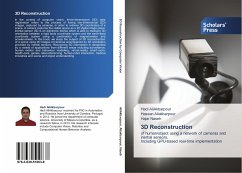In the context of computer vision, three-dimensional (3D) data registration refers to the process of fusing two-dimensional (2D) images, captured by cameras, in order to retrieve 3D coordinates of a scene. A camera captures the visible space as a 2D digital image plane. Inertial sensor (IS) is an electronic device which is able to measure 3D orientation between a rigid body coordinate system and the earth-fixed coordinate system using a combination of magnetometer and accelerometer. In this book, we study the subject of 3D reconstruction of a scene using 2D images of cameras accompanied by 3D orientation provided by inertial sensors. Recovering 3D information is demanded by a variety of applications from different areas including surveillance, human motion and behaviour modelling, virtual-reality, smart-room, health-care, games, teleconferencing, human-robot interaction, medical industries and scene and object understanding.
Bitte wählen Sie Ihr Anliegen aus.
Rechnungen
Retourenschein anfordern
Bestellstatus
Storno








